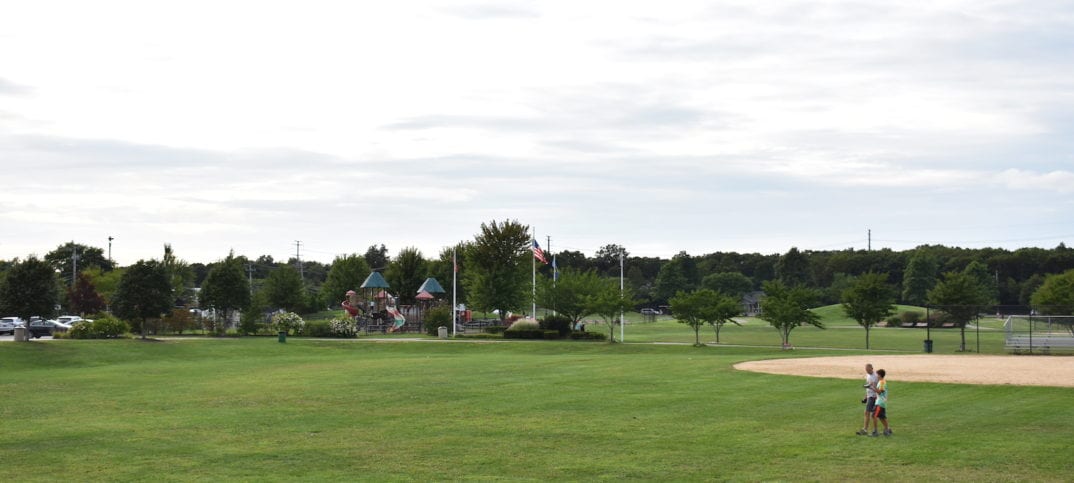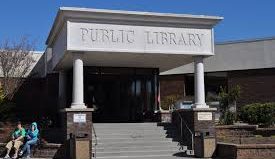A flash of green among the gray, the short hills that roll along the side of Route 25A in Mount Sinai are strewn with people. Men and women jog, kids scream and laugh playing baseball and soccer. Children run up those green hills, then fall and let themselves tumble down the gentle slopes.
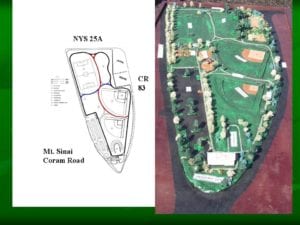
Some developers have talked about creating a “town square” for the hamlet of Mount Sinai, but for lovers of Heritage Park, there already is one.
“There it is, Heritage Park — it’s one of the most beautiful parks of its kind that I’ve ever seen,” said New York State Assemblyman Steve Englebright (D-Setauket). “It came together from the cooperation of so many wonderful people willing to pull together.”
Nearly 20 years ago, local residents became heated about plans to develop the site for the home improvement giant, Home Depot. The site, which was once a pumpkin farm, joined with other properties like the Davis Peach Farm in an agrarian setting. Decades of home development turned the area into small strips of business sandwiched in between residential neighborhoods.
Heritage Park went in the opposite direction. A successful agreement between Suffolk County and the Town of Brookhaven meant the county bought the site by using the Community Greenways Fund, while the town built the park amenities like the baseball and soccer fields. The nonprofit organization Heritage Trust continues to operate the park, along with Brookhaven town. The trust hosts multiple carnivals and other events throughout the year as a means of raising money. The trust also rents out the Heritage Center for public events.
But more than that, the trust has become a lightning rod for Mount Sinai, and even well beyond.
The history of Heritage
Very few dreams become reality, at least to specific designs.
But original plans for Heritage Park, known also as The Wedge, and mockups bear a striking resemblance to how the park has shaped up 20 years after those original designs.
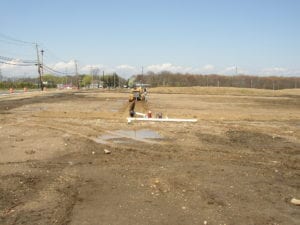
Fred Drewes, a longtime park volunteer and Mount Sinai resident, originally came to the Mount Sinai Civic Association back in 1988 with the idea of a hamlet study, and the idea was resurrected in the late 1990s, co-chaired with then civic president Lori Baldassare. Within those designs, he proposed a park, one that would become the focal point for the North Shore that had once been McGovern Sod Farm.
This was during a time when the rural past of the hamlet was being laid over with brick and concrete. One housing development after another changed the tenor of Mount Sinai. The last few farms on the south side of Route 25A started to close and look to sell their property, and a few big names started eyeing those parcels.
“The development pattern of western Long Island was going to make it impossible for Mount Sinai to escape being visually damaged and swallowed up,” Englebright said.
Among the legal action taking place at the location of the Davis Peach Farm, one of those maligned developments was a potential Home Depot on a plot of land that had been a pumpkin and sod farm.
At the southern tip of The Wedge, a space of only about one acre that had commercial zoning, representatives of Home Depot approached the property owners who were looking to sell. The rest of the property was zoned residential.
Baldassare, who has spent the past 20 years as the on-and-off again Heritage Trust president, has long been in the trenches over the fate of The Wedge. Home Depot would end up the line in the sand for Mount Sinai residents. As civic president, she asked Drewes to revive his hamlet study and plan for a park. She also was a leader among residents campaigning against the home supply chain, getting people to tie green ribbons around their mailboxes all across the hamlet to show their support.
“We ended up competing for them with land,” Baldassare said. “We had thousands of ribbons up all over the place.”
The next task was to make sure, as Englebright put it, “the same thing didn’t come back in some virulent form.”
In 1999, the civic authored a proposal for Suffolk County to buy the parkland. Of course, in government, nothing is ever that simple.
A state, a county, a town, a civic
Rare is it that all levels of government from the top down work together on such a large project as was Heritage Park, and while it wasn’t all easy, the results stand.
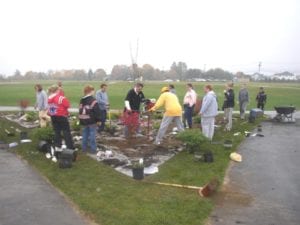
Still, the process was grueling at times. Both Brookhaven town and the county wanted active recreation, namely baseball and soccer fields. The town, especially, wasn’t into designing passive space with ingredients of a walking path and playground, but mostly a space for, as Drewes called it, “free play.” He remembers the then town parks commissioner mentioning he would never use such a space for jogging, so close as it was to two major roads.
“The way the greenways program worked is they needed a partner to maintain it,” Baldassare said. “They weren’t willing to develop it, they needed a partner, and the county said they wanted a municipal partner, but the town was not willing to do all the things we wanted in the park.”
Before they were willing to sign on to the county, the town also wanted to have a civic partner.
The assemblyman came into the picture, agreeing with the civic about needing to maintain the heritage of the area. He said he reached out to his colleagues at the state, county and town levels to help open those conversations.
One difficulty they encountered was finding funds to buy the particular section of The Wedge that was still zoned for commercial.
The property was owned by Vinny Bove, a local entrepreneur and developer. Englebright recalled him as a “rather rugged individual,” and didn’t expect that he would be such a kindred spirit. Speaking with him, he found Bove was more than willing to keep the property up for sale until the state could gather the funds for the civic to buy the property.
“His welcoming attitude and his willingness to embark on the journey of uncertainty that was worthy of the community’s heritage, made it possible,” Englebright said.
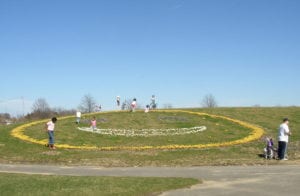
Of course, the next issue was that the civic had to be legally able to accept state funds, needing to be a 501(c)(3) nonprofit, categorized as a land trust. It was then the Heritage Trust was formed, which incorporated in 2000.
The past trust president and now treasurer recalls much haggling over which municipality would fork over the funds for which part of the project. After the section was designated for park, it would be years before the first shovels finally entered the ground in 2003 when it all started to come together.
The county would buy most of the land, with one section now owned by the trust. The town would build the walking paths and baseball and soccer fields, and town lawnmowers continue to maintain the space.
“All the voices were speaking of the green space,” Englebright said. “Just amazing loving work the parks department of the town invested itself into.”
20 years, 20 more
From a few baseball fields and passive green, the park grew. More state assembly grants and loads of private fundraising helped gather the money to build the barnlike structure that has become the Heritage Center, the main headquarters not just for the trust but also for the civic groups and a gathering spot for other local groups and events.
Amy Satchell was a volunteer since almost the beginning, helping to fundraise for the center and installation of the playground, which went up years after the park was fully built. Every year around the holidays Satchell goes to help decorate the center and the large pine tree just outside its doors.
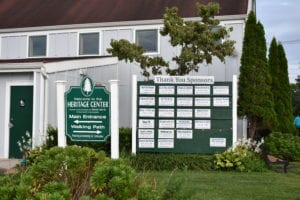
“Many people had an idea that it would be the town center, the town square of Mount Sinai,” she said. “You can see now after all this time all the wonderful amenities that are provided.”
Drewes has seen more and more amenities come to the park, including his own idea for the now-annual parade of flags, a display of flags from nations across the world on the Avenue of America, a stretch of the walkway that encloses the park.
The longtime Mount Sinai resident, now 83, is retired. He can lean back on a park bench and look at all the work he and his civic compatriots have helped accomplish.
“I’m gratified and extremely happy that what we as citizens proposed and volunteers worked tirelessly to create is valued by so many people,” he said.
Suffolk County Legislator Sarah Anker (D-Mount Sinai) said she has seen the effectiveness of the project and has proposed a similar agreement for a spot in Middle Island. The location is the site of a now-demolished K-Mart across from Artist Lake along Middle Country Road.
“It has inspired me to take the model and replicate it,” Anker said.
Baldassare said that as the park reaches its 20th year, very few things remain as part of the original design, with only a splash pad and a few other odds and ends left. For the trust, it means the end of an era, and the start of a new one.
Fundraising has always been a difficulty, with the trust having an annual budget of around $300,000, the members have to fundraise what they don’t get through sponsorships and grants almost all by themselves. These funds also help to pay the several part-time staffers the trust needs for its ongoing efforts.
“People think it must be taxpayer dollars that take care of the center, and it’s not, we always have to raise money,” Satchell said.
They host events every year like the spring and summer carnivals, but those are dependent on weather. The trust treasurer recalled one year that was incredibly lean because of adverse weather conditions during one of its main fundraising events.
The park always requires more volunteers and is looking for more ideas to take the park through the next 20 years.
Though many who visit the park assume that it must have always been there, for the trust and its volunteers, that can only be a good thing.
“When people say that, for them, the park has always been there, that’s fantastic,” Satchell said. “We want it to be that anchor in the community that people think it’s always been there. I do hope it always will be.”
This article was amended Oct. 2 to change the captions within the pictures to better reflect what they present. Several pictures were changed to say they were taken by Fred Drewes.

